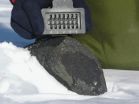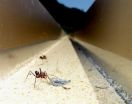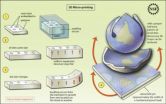(Press-News.org) A recent summit that brought together international multidisciplinary experts has provided a foundation for addressing what is the leading cause of disability in the United States: osteoarthritis.
Currently, validated pharmacologic interventions do not exist for effectively eliminating pain and restoring function during progression of osteoarthritis, a disease whose prevalence is expected to dramatically rise within the next decade and inflict a huge economic impact on society. The summit, which was hosted by Hospital for Special Surgery in New York City, is a first step in building consensus about what needs to be done to advance treatments and design preventive strategies. Consensus statements and analysis from the summit appear as part of a series of papers in Volume 8, Issue 1, of the Hospital for Special Surgery Journal published on March 9.
"The summit included leading scientists and researchers across all of the broad disciplines related to osteoarthritis, ranging from very basic cell and molecular biology, to biomechanics, to epidemiology and clinical trials," said Steven Goldring, M.D., chief scientific officer at Hospital for Special Surgery (HSS) who, along with Timothy Wright, Ph.D., Kirby chair of orthopedic biomechanics at HSS, co-directed the Osteoarthritis Summit: Frontiers in OA research, Prevention, and Care. "This is a clinical disorder in which there are multiple factors that contribute to the initiation, progression and disease outcome, and the only way we are going to be able to define the underlying mechanisms and develop effective therapies is to bring together individuals who are experts in each of these disciplines and create a forum for discussion and exchange of knowledge," said Dr. Goldring.
Although joint replacement surgery is an effective late-stage treatment for osteoarthritis and much has been learned about the disease, little progress has been made in terms of preventing or slowing the progression of osteoarthritis. The summit brought together 35 experts in the field, including research scientists, clinicians, physical therapists, government officials, and members of the pharmaceutical, device and insurance industries. Over the two-day summit, the experts focused on the classification, pathology, diagnosis, assessment, treatment, and preventative and public health strategies for management of osteoarthritis.
"A forum for osteoarthritis that brings together experts from such diverse specialties and interests for discussion and exchange of knowledge doesn't really exist under normal circumstances because these communities tend to publish in their own specialty journal or attend their own specialty meeting," said Dr. Goldring, who is also the Richard L. Menschel Research Chair at HSS. "The summit opened the lines of communication that are needed to advance the understanding of the disease and come up with new treatments and more effective strategies for osteoarthritis prevention and management."
The summary of results in Volume 8, Issue 1, of the HSS Journal highlights a number of steps that need to be taken. For example, the summit concluded that the current classification system for osteoarthritis is inadequate. The experts proposed a classification tree that identifies osteoarthritis as spontaneous or induced, and further classifies the disease based on symptoms, associated bone structural abnormalities, cartilage and related joint tissue abnormalities, and stage of disease progression.
"Osteoarthritis is an extremely heterogeneous disorder in terms of the factors that contribute to the loss of joint function," said Dr. Goldring. "If we are going to design treatments for patients, we need to have a classification system that describes what is really driving the process. As the disease progresses, the mechanisms that contribute to signs, symptoms and destruction of the joint tissues vary in a given patient and throughout the course of the disease. We need to be able to know where a patient is in the progression of the disease to be able to target those specific processes that are responsible for the symptoms and loss of joint function and select the appropriate therapy."
To focus discussion at the summit, participants were challenged to develop answers to critical questions and issues, and these answers are elaborated on in the individual articles in Volume 8, Issue 1, of the HSS Journal. For example, a question regarding the optimal tools for diagnosis and for monitoring progression and response to therapy brought about a consensus about the current state and future of biomarkers for osteoarthritis. There is a great need to educate the government and regulatory agencies about realistic and more meaningful markers that can be used for disease staging and to evaluate therapies. Currently, early research has identified blood or urine markers that can provide researchers with an idea of what is going on inside an affected joint without clinicians having to do an invasive procedure, but further research is needed to validate these markers and find better ones.
Another hot topic was prevention, specifically weight loss in obese patients. Weight reduction is generally ignored among therapeutic interventions when, in fact, it has been shown to be successful in treating pain in obese patients with osteoarthritis. Encouraging insurance companies to pay for supervised exercise and weight loss interventions is one avenue that needs to be explored.
Another consensus reached was that treatment approaches that integrate multidisciplinary health professions are needed, rather than a patient seeking a second and third opinion from multiple physicians. From a public health standpoint, there is a great need to emphasize nonpharmacological therapies, such as exercise, and physicians typically do not have the time to provide adequate lifestyle advice to patients.
"The summit is unique in that we brought together the most expert people in the world across all of the relevant disciplines. We spent the majority of our time engaged in breakout sessions in discussions to address the challenging questions and issues related to osteoarthritis diagnosis, treatment and management. It is probably the most current overview of where the field stands at this point," said Dr. Goldring, referring to the meeting summaries published in the journal.
According to the summit attendees, many pharmaceutical companies have dropped out of the field of osteoarthritis research and drug development because of the complexity of the disease and the regulatory barriers standing in the way of bringing a drug to market. Disseminating information from the summit will hopefully spur research forward and help to break down many of the barriers that have prevented advances in the care and management of patients with osteoarthritis.
The conference featured 35 distinguished speakers from institutions including the National Institutes of Health, the Arthritis Foundation, Hospital for Special Surgery, Rush Medical Center, Brigham and Women's Hospital, Tufts, Wake Forest, Duke University, McGill University in Canada, and the University of Sydney. Funding for the summit was supplied by the National Institutes of Health-funded Weill Clinical Translational Science Center, Amgen, Endo Pharmaceuticals, Genzyme Biosurgery, Novartis Pharmaceuticals, Pfizer and Zimmer.
###
About Hospital for Special Surgery
Founded in 1863, Hospital for Special Surgery (HSS) is a world leader in orthopedics, rheumatology and rehabilitation. HSS is nationally ranked No. 1 in orthopedics, No. 2 in rheumatology, No. 19 in neurology, and No. 16 in geriatrics by U.S.News & World Report (2011-12), and is the first hospital in New York State to receive Magnet Recognition for Excellence in Nursing Service from the American Nurses Credentialing Center three consecutive times. HSS has one of the lowest infection rates in the country. From 2007 to 2011, HSS has been a recipient of the HealthGrades Joint Replacement Excellence Award. HSS is a member of the NewYork-Presbyterian Healthcare System and an affiliate of Weill Cornell Medical College and as such all Hospital for Special Surgery medical staff are faculty of Weill Cornell. The hospital's research division is internationally recognized as a leader in the investigation of musculoskeletal and autoimmune diseases. Hospital for Special Surgery is located in New York City and online at www.hss.edu.
For more information contact:
Phyllis Fisher
212-606-1197
FisherP@hss.edu
Tracy Hickenbottom
212-606-1197
HickenbottomT@hss.edu
Osteoarthritis Summit delineates shortcomings of research and path forward
2012-03-12
ELSE PRESS RELEASES FROM THIS DATE:
Mid-Atlantic suburbs can expect an early spring thanks to the heat of the big city
2012-03-12
If you've been thinking our world is more green than frozen these days, you're right. A recent study has found that spring is indeed arriving earlier – and autumn later – in the suburbs of Baltimore and Washington, D.C. The reason? The urban landscape traps heat in the summer and holds it throughout the winter, triggering leaves to turn green earlier in the spring and to stay green later into autumn. The result is a new, extended growing season.
Scientists used high-resolution satellite data collected over the past 25 years to look at the number days that trees have green ...
LA BioMed investigator, Dr. Rowan Chlebowski, co-authors study on menopausal hormone therapy
2012-03-12
LOS ANGELES (March 9, 2012) – Rowan T. Chlebowski, M.D., Ph.D., an LA BioMed investigator whose research activities have focused on breast cancer therapy and prevention, and chronic diseases impacting women's health, is co-author of a study that indicates that women who use the estrogen-only form of menopausal hormone therapy appear less likely to develop breast cancer in the longer term, according to new research which was recently published The Lancet Oncology.
A follow-up study of over 7,500 women from the Women's Health Initiative (WHI) trial who took estrogen for ...
Health monitoring? There's an app for that
2012-03-12
Researchers in New Zealand have developed a prototype Bluetooth-enabled medical monitoring device that can be connected wirelessly to your smart phone and keep track of various physiological parameters, such as body temperature, heart rate, blood pressure and movements. The prototype could be extended to include sensors for other factors such as blood glucose as well as markers for specific diseases. The connectivity would allow patients to send data directly to their healthcare provider and receive timely advice and medication suggestions.
Writing in the International ...
Environmentally friendly cleaning and washing
2012-03-12
Detergents are everywhere – in washing powders, dishwashing liquids, household cleaners, skin creams, shower gels, and shampoos. It is the detergent that loosens dirt and fat, makes hair-washing products foam up and allows creams to be absorbed quickly. Up until now, most detergents are manufactured from crude oil – a fossil fuel of which there is only a limited supply. In their search for alternatives, producers are turning increasingly to detergents made from sustainable resources, albeit that these surfactants are usually chemically produced. The problem is that the ...
TacSat-4 enables polar region SatCom experiment
2012-03-12
WASHINGTON -- The U.S. Coast Guard Cutter HEALY (WAGB 20) successfully experimented with NRL's TacSat-4 communications satellite, Jan. 24, by communicating from the Bering Sea off the western coast of Alaska to Coast Guard Island, Alameda, Calif.
Returning from an escort and icebreaking mission to Nome, Alaska, assisting the Russian tanker Renda delivery of emergency fuel to the town, USCGC HEALY — Coast Guard's only polar icebreaker — was approximately 260 nautical miles south of the Arctic Circle at the time of the test.
Deployed into a unique, highly elliptical ...
Mapping the Moho with GOCE
2012-03-12
The first global high-resolution map of the boundary between Earth's crust and mantle – the Moho – has been produced based on data from ESA's GOCE gravity satellite. Understanding the Moho will offer new clues into the dynamics of Earth's interior.
Earth's crust is the outermost solid shell of our planet. Even though it makes up less than 1% of the volume of the planet, the crust is exceptionally important not just because we live on it, but because is the place where all our geological resources like natural gas, oil and minerals come from.
The crust and upper mantle ...
Meteorites reveal another way to make life's components
2012-03-12
Creating some of life's building blocks in space may be a bit like making a sandwich – you can make them cold or hot, according to new NASA research. This evidence that there is more than one way to make crucial components of life increases the likelihood that life emerged elsewhere in the Universe, according to the research team, and gives support to the theory that a "kit" of ready-made parts created in space and delivered to Earth by impacts from meteorites and comets assisted the origin of life.
In the study, scientists with the Astrobiology Analytical Laboratory ...
Infection control certification associated with lower MRSA infection rates
2012-03-12
Washington, DC, March 9, 2012 -- Hospitals whose infection prevention and control programs are led by a director who is board certified in infection prevention and control have significantly lower rates of methicillin-resistant Staphylococcus aureus (MRSA) bloodstream infections (BSI) than those that are not led by a certified professional, according to a new study published in the March issue of the American Journal of Infection Control, the official publication of APIC - the Association for Professionals in Infection Control and Epidemiology.
A team of researchers ...
Orientation of desert ants: Every cue counts
2012-03-12
Desert ants have adapted to a life in a barren environment which only provides very few landmarks for orientation. Apart from visual cues and odors the ants use the polarized sunlight as a compass and count their steps in order to return safely to their home after searching for food. In experiments with ants of the genus Cataglyphis in their natural habitats in Tunisia and Turkey, behavioral scientists of the Max Planck Institute for Chemical Ecology in Jena, Germany, have now discovered that ants can also use magnetic and vibrational landmarks in order to find their way ...
Researchers 'print' polymers that bend into 3-D shapes
2012-03-12
Christian Santangelo, Ryan Hayward and colleagues at the University of Massachusetts Amherst recently employed photographic techniques and polymer science to develop a new technique for printing two-dimensional sheets of polymers that can fold into three-dimensional shapes when water is added. The technique may lead to wide ranging practical applications from medicine to robotics
The journal Science publishes the research in its March 9 issue.
Researchers used a photomask and ultraviolet (UV) light to "print" a pattern onto a sheet of polymers, a technique called photolithography. ...





